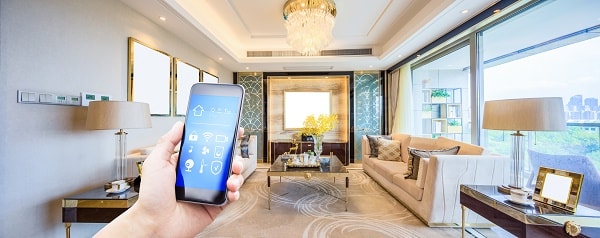This post about smart homes was written by Steve Cooper.
Less than a decade ago smart thermostats and light bulbs began infiltrating homes. Early adopters were able to get a glimpse at life as they had seen it portrayed in so many science fiction television shows and movies. This meant the temperature would automatically adjust based on lifestyle habits rather than a single temperature setting. Lighting would automatically change depending on the time of day or activity. To those who used these initial smart devices the benefits were obvious. Today, the rapid adoption of smart devices in the home and the ecosystem they have spawned has matured into a more robust and capable smart home. And as was obvious a few weeks ago at CES, where so many smart devices were on display—smart homes are getting smarter.
When the initial smart devices launched, they were limited in their abilities to interact with the world. The thermostat wasn’t talking to your light bulbs. Today, when your smart window shades go down, it can automatically trigger your lights to turn on to the perfect color and the temperature and your thermostat can adjust to save energy. As smart homes become smarter, more devices are able to connect and talk to one another prompting even greater automation. For example, when you add a smart lock on your front door and a smart vacuum cleaner to the equation, the mere act of leaving the house for your office can prompt a geolocation command to lock the door, turn off the lights, turn off the air conditioning and initiate vacuuming. This is not a scene from The Jetsons—this technology exists today.
The true power of smart home technology is starting to be felt from the abundance of devices and their expanded capabilities; more robust machine learning algorithms to predict and adjust based on your habits and lifestyle; more capable hubs for smart homes; and a new proliferation of devices that deliver on-demand commands, such as smart speakers and wearable devices like smartwatches.
One of the foundational communication technologies used in smart devices is a protocol named Z-Wave. It launched in 2001 and today there are now over 2,400 products using this communication standard. To set up and control all of these devices companies like Apple and Samsung have created solutions that allow users to easily enable multiple devices to interact with each other. When you include third-party services like IFTTT, which further allows users to create “recipes” beyond device-to-device communication, you’ve got real magic on your hands. For example, you can connect gameplay action reported by ESPN to your lights and when your favorite baseball team hits a home run the lights in your living room can flash in the colors of your team.
Newer technology has seen a great expansion in the kitchens of smart homes. LG, for example, has introduced a smart refrigerator with a display on the door where users can search recipes and send the temperature setting to the oven to get the cooking process started. And because it’s so smart, the days of worrying about your smart smoke detector telling the smart lights to turn red and the smart fan to turn on are already coming to a close.
As the number of products for smart homes expands, it can start to become cumbersome. Sometimes you just want things to work without a lot of direct input. This is where the power of cloud computing comes in. Access to these super computers enables all the smart objects to learn and get smarter the more you use them—machine learning. This functionality makes them more efficient and useful. So, if you wonder if smart homes are getting smarter, the answer is a definitive yes!
Steve Cooper is cofounder of Hitched. He has covered technology for 17 years—and lives in a smart home.







